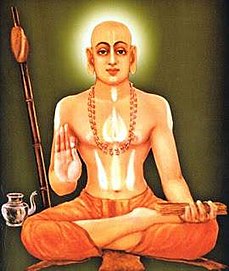Narayanacharya
Narayanacharya (IAST:Nārāyaṇācārya) (c. 1600 – c. 1660), was an Indian scholar and philosopher of Dvaita Vedānta tradition. He was the disciple of Vedavyasa Tirtha of Uttaradi Math and is the most celebrated name in the annals of the great dvaita-advaita debate.[1] Narayanacharya is notable for his work Advaita Kalanala, which is a refutation work to Madhvamatamukhamardana of Appayya Dikshita. Indologist B. N. K. Sharma writes, "The Advaita Kalanala is a scathing criticism of the Madhvamatamukhamardana of Appayya. The carping criticisms and bitter personal attacks of the Dikshita are vigorously returned by Narayana. He loses no opportunity to pay the critic in his coin and with compound interest. The tone of the work is thus retaliatory and bitingly sarcastic".[1] Sharma also writes, "Narayanacharya was one of the fiery champions of the Dvaita school, that rose to defend it against the slashing attacks of Appayya Dikshita and others".[1] American historian Anthony Grafton and classicist Glenn W. Most considered the work Advaita Kalanala along with the Abhinava-Gada of Satyanatha Tirtha as a new mace which broke the heads of non-dualists like Appayya Dikshita.[2]
Sri Narayanacharya | |
|---|---|
| Personal | |
| Born | Narayanacharya 1600 Present day North Karnataka |
| Died | 1660 Present day North Karnataka |
| Religion | Hinduism |
| Philosophy | Dvaita,Vaishnavism |
| Religious career | |
| Guru | Vedavyasa Tirtha |
| Literary works | Advaita Kalanala |
| Part of a series on |
| Dvaita |
|---|
 |
|
Literature
|
|
|
Holy places |
| Hinduism portal |
Life
Almost nothing is known about Narayanacharya's early life but according to some hagiographies he was born in North Karnataka in 1600 and his father name was Vishvanatha. Tradition asserts that Narayanacharya was the elder brother of Vyasa Ramacharya, who was the author of the famous Nyayamrta Tarangini. Indologist B. N. K. Sharma says, The only information Narayanacharya gives about himself is that he is "Vaishvānathih", son of Vishvanatha and his guru was Vedavyasa Tirtha of Uttaradi Math in the sixth introductory verse of his Madhvamantrarthamanjari.[1] This by itself is not sufficient to justify his identification with the elder brother Tarangini Ramacharya being the same name of Narayanacharya, as proposed by Gaudagiri Gopalakrishnacharya and is supported by V. Prabhanjan in the December and January issues of Tattvavada (1979–1980).[1] Tarangini Ramacharya has given us ample information about himself about his father name Vishvanatha, his gotra Upamanyu, and his family surname "Vyasa", besides mentioning that he had an elder brother Nārāyaṇācārya who was a veteran scholar in Vyakarana and other Shastras and that he had his scholastic training under him. In the absence of any definite information from the Narayanacharya of Advaitakalanala about his gotra and family surname, it is purely conjectural to identify the two Narayanacharya's on the sole basis of their fathers' name has been the same which may be a sheer coincidence.[1]
Works and legacy
Narayanacharya authored three works consisting of polemical tracts, commentary and Independent treatise. Except Advaitakalanala his two other works, Madhvamantrarthamanjari and Vishnutattvaviveka remaines unprinted.[1][3][4]
Advaita Kalanala
Advaitakālānala is a polemical and expositional work in five chapters and runs to about 8,000 stanzas.[5] It is a refutation work for the theological controversies provoked by Appayya Dikshita by his work Madhvamatamukhamardana. Indologist B. N. Krishnamurti Sharma says, "In this work carping, criticisms, and bitter personal attacks of the Dikshita are vigorously returned by Narayanacharya".[6] Sharma writes, "He writes a vigorous and animated style, full of repartees, spicy anecdotes, and colorful analogies. Indologist B. N. K. Sharma writes, "The work is could be pronounced to be a thoroughgoing and final refutation of Dikshita's work".[5]
References
- Sharma 2000, p. 432.
- Grafton & Most 2016, p. 108.
- Bhattacharya 1970, p. 310.
- Fisher 2017, p. 117.
- Sharma 2000, p. 433.
- Sharma 2000, p. 434.
Bibliography
- Sharma, B. N. Krishnamurti (2000). A History of the Dvaita School of Vedānta and Its Literature, Vol 1. 3rd Edition. Motilal Banarsidass (2008 Reprint). ISBN 978-8120815759.CS1 maint: ref=harv (link)
- Grafton, Anthony; Most, Glenn W. (2016), Canonical Texts and Scholarly Practices: A Global Comparative Approach, Cambridge University Press, ISBN 978-1107105980CS1 maint: ref=harv (link)
- Bhattacharya, Sibajiba (1970). The Encyclopedia of Indian philosophies, Volume 1. Motilal Banarsidass.CS1 maint: ref=harv (link)
- Devadevan, Manu V. (2016). A Prehistory of Hinduism. Walter de Gruyter GmbH & Co KG. ISBN 978-3110517378.CS1 maint: ref=harv (link)
- Fisher, Elaine M. (2017), Hindu Pluralism: Religion and the Public Sphere in Early Modern South India, University of California Press, ISBN 978-0520293014CS1 maint: ref=harv (link)